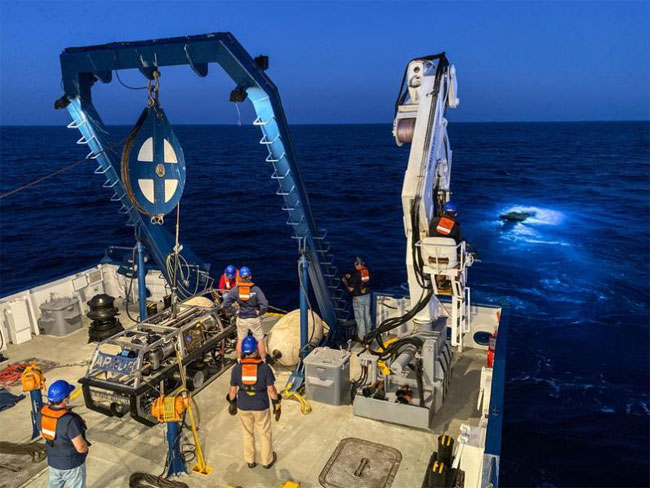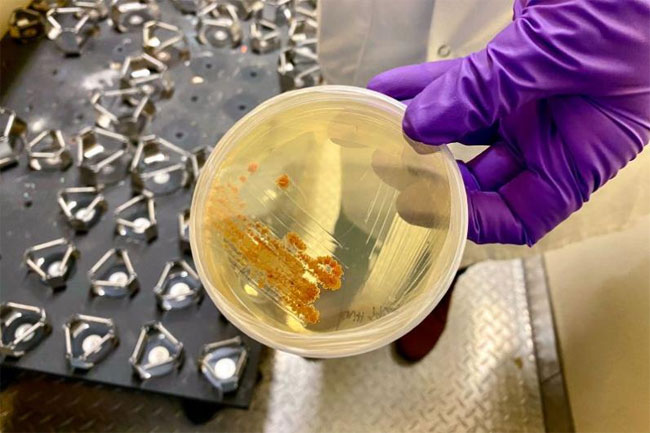A new drug specifically targeting neuroblastoma has been derived from a type of bacteria found at the bottom of the ocean at a depth of 1981 meters. At the medical center of the University of California, Irvine (UCI), a phase 2 trial is currently underway for this drug, showing promising results.
The Cancer-Fighting Power of Marine Actinomycetes
Paul Jensen, a scientist from the Scripps Institution of Oceanography (University of California San Diego), is focused on the white sediment layers covering the ocean floor. The invertebrates clinging to the seafloor harbor countless microorganisms, including marine bacteria that are invisible to the naked eye.
Despite their tiny size, marine bacteria play a crucial role in recycling nutrients in the ocean and providing food for other organisms. Many species of marine bacteria also produce chemicals to defend themselves against predators and pathogens.

Research vessel operated by the Ocean Exploration Trust (OET) during a hunt for cancer-fighting marine bacteria. (Photo source: Ocean Exploration Trust/NautilusLive)
Due to their mechanisms for attracting, detecting, and eliminating other bacteria, some marine bacteria have proven beneficial for humans. From these bacteria, scientists have developed potent anti-tumor drugs, antibiotics, antivirals, and other medications.
Paul Jensen has discovered numerous useful molecules in the ocean while collecting samples at depths of 2000 meters below the surface. Because deep-sea bacteria must constantly adapt to their environment, the compounds they produce are often unique.
To date, over 60% of the active compounds found in various bacterial species have been identified. Nearly 75% of these have originated from a single bacterial class: Actinomycetes. Scientists have uncovered countless new drugs derived from actinomycetes that live in soil.
They have also isolated the first actinomycete compounds with anti-tumor properties, leading to the development of various drugs used to treat leukemia, lymphoma, and several other types of cancer. However, by the 1980s, as the supply of new compounds dwindled, pharmaceutical companies began racing to discover new actinomycetes.
The Journey of Drugs from the Sea
In 1988, Paul Jensen, then a laboratory technician, partnered with William Fenical, a chemist from the Scripps Institute, to focus on searching for natural drugs. In June 1989, the Fenical-Jensen duo traveled to the waters of the Bahamas to collect sediment samples from 15 different locations at a depth of 33 meters.
Upon returning to the lab and culturing the samples, the two scientists discovered 289 distinct actinomycete strains. Among these bacteria, they identified a new genus of the species Salinispora that had never been seen on land. They also found a strain of Salinispora that only thrives in saltwater. Working with their colleagues, Jensen confirmed the presence of two Salinispora species in the Bahamian samples, both of which produced unique active compounds.
One of these was the strain S. tropica, which generated a molecule that completely changed the careers of both men. When Fenical tested it on an untreatable human colon cancer cell line, the compound yielded remarkable results.

Salinispora tropica can be cultured in the lab. (Photo source: Stephanie Stone)
At the National Cancer Institute (NCI), when testing the new compound against 60 different cancer cell lines, the results were astonishing: The compound they named Salinosporamide A was effective against several cancer lines.
In 2001, Dr. Paul Jensen and his colleagues sequenced the genome of S. tropica and found that nearly 10% of its DNA (the largest known percentage from any species) produced 17 active compounds, most of which were not revealed through standard culturing methods.
Today, Dr. Jensen and other team members have developed even more tools to uncover additional molecules. They can extract all molecules from the same samples to identify chemical structures that align with assembly instructions in gene clusters.
Since the initial discovery of the inhibitor Salinosporamide A, scientists at the Scripps Institute have identified over 100 active compounds.
Fenical and Jensen have observed how Salinosporamide A functions against cancer lines. At the research center Nereus Pharmaceuticals (NP), scientists have put Salinosporamide A through standardization processes.
This compound works by targeting the proteasome of the cell (a sort of waste disposal unit that chews up used proteins) and preventing it from functioning, ultimately clogging and killing the cell. Scientists acknowledge that this is a crucial pathway to eliminate multiple myeloma. Therefore, NP has focused on eradicating this disease.
By 2007, they had used Salinosporamide A (also known as Marizomib) to conduct phase 2 clinical trials on patients with multiple myeloma.
Despite some successes in eradicating multiple myeloma, many patients undergoing the trials reported temporary neurological side effects, including dizziness and speech impairment.
In the following years of research on neuroblastoma stem cells, scientists concentrated on inhibiting the proteasome as a promising strategy to target tumors associated with this disease.
To date, a drug called Marizomib has made progress in phase 2 clinical trials, and a pharmaceutical company has invested in further testing.
Neuroblastoma is one of the most dangerous types of tumors. The average survival time for patients diagnosed with this disease is only 15 months, making it the deadliest form of brain cancer. Worse still, this disease causes a range of neurological side effects, including paralysis, loss of speech, vision impairment, and seizures. If successful, the new drug derived from marine bacteria could herald a bright future for patients unfortunate enough to suffer from this condition.



















































